Improvement of Torque Performance and Energy Density of PM-Type Vernier Motor Utilizing Saddle Coil and Salient Pole
Abstract
1. Introduction
2. Structure and Principle
2.1. A DHPM-Type Vernier Motor
- St: stator teeth;
- Nr: poles of the PM of the rotor;
- Ns: poles of the PM of the stator;
- Nr: magnetic poles of the rotor;
- Np: number of coil poles.
2.2. A New DHPM Vernier Motor Using Saddle Coil and Salient Pole
3. Performance Comparison of the Proposed and Other Models
4. Comparison of Specifications of the DHPM-Type Vernier Motor for the Proposed DHPM Vernier Motor and Compatible Model
5. Conclusions
- The proposed model was prepared by replacing the stator’s PMs with salient poles. The analysis results demonstrate that the induced voltage is almost equal to that of the DHPM-type vernier motor prepared by adding PMs to electromagnets.
- We prepared the proposed model by setting the inclination angle at 7.5°. The high torque of the proposed model confirms its effectiveness. The change rate in the interlocking magnetic flux of the coil increased. In addition, the area of the interlinkage magnetic flux of the silent pole increased with the change in the inclination angle. In the proposed DHPM-type vernier motor to which the angle was applied, the interlinkage magnetic flux area of the salient pole and the temporal change rate in the interlinkage magnetic flux of the stator increased by the inclination angle. Additionally, a greater torque was obtained, and its effectiveness was confirmed.
- Compared with the other motors, such as the SPM-type vernier motor and DHPM-type vernier motor, the magnetic flux density of the proposed DHPM vernier motor increased depending on the inclination angle. The space volume ratio improved at the inclination angle of 7.5°, which proves that the space utilization efficiency increased and both the energy density per unit volume and per unit weight improved.
- By comparing the load-free rotation number (rpm) and the maximum torque (Nm) when starting a proposed DH vernier motor and a conventional DH vernier motor, we demonstrated that the proposed DHPM vernier motor can produce lower-speed high-torque characteristics. Following this research, research on design optimization and miniaturization will be conducted by comparing the performance and analyzing the magnetic flux density with the inclination angle (or the like) to improve the energy density per unit volume and per unit weight for practical use for a new DHPM vernier motor.
Author Contributions
Funding
Institutional Review Board Statement
Informed Consent Statement
Data Availability Statement
Conflicts of Interest
References
- El-Refaie, A.; Raminosoa, T.; Reddy, P.; Galioto, S.; Pan, D.; Grace, K.; Alexander, J.; Huh, K. Comparison of traction motors hat reduce or eliminate rare-earth materials. In Proceedings of the IEEE Energy Conversion Congress and Exposition, Milwaukee, WI, USA, 18–22 September 2016; pp. 1–8. [Google Scholar]
- Takeno, M.; Chiba, A.; Hoshi, N.; Ogasawara, S.; Takemoto, M.; Rahman, M. Test results and torque improvement of the 50-kw switched reluctance motor designed for hybrid electric vehicles. IEEE Trans. Ind. Appl. 2012, 48, 1327–1334. [Google Scholar] [CrossRef]
- Petrov, I.; Pyrhönen, J. Performance of Low-Cost Permanent Magnet Material in PM Synchronous Machines. IEEE Trans. Ind. Electron. 2013, 60, 2131–2138. [Google Scholar] [CrossRef]
- Ishizaki, A.; Tanaka, T.; Takasaki, K.; Nishikata, S.; Watanabe, K.; Katagiri, A. Theory and torque characteristics of PM vernier motor. IEEJ Trans. Ind. Appl. 1993, 113-D, 1192–1199. [Google Scholar] [CrossRef]
- Lee, C.H. Vernier motor and its design. IEEE Trans. Power App. Syst. 1963, 82, 343–348. [Google Scholar] [CrossRef]
- Toba, A.; Lipo, T.A. Generic torque-maximizing design methodology of surface permanent-magnet vernier machine. IEEE Trans. Ind. Appl. 2000, 36, 1539–1546. [Google Scholar]
- Atallah, K.; Rens, J.; Mezani, S.; Howe, D. A novel pseudo direct-drive brushless permanent magnet machine. IEEE Trans. Magn. 2008, 44, 4349–4352. [Google Scholar] [CrossRef]
- Ishizaki, A.; Shibata, Y.; Watanabe, K.; Saito, K. Low speed high torque drive system applying vernier motor torque. IEEJ Trans. Ind. Appl. 1991, 111, 785–793. [Google Scholar] [CrossRef][Green Version]
- Kakihata, H.; Kataoka, Y.; Takayama, M.; Matsushima, Y.; Anazawa, Y. Design of surface permanent magnet-type vernier motor. J. Int. Conf. Electr. Mach. Syst. 2013, 2, 127–133. [Google Scholar] [CrossRef][Green Version]
- Zhang, H.; Shao, Y.; Kou, B.; Qu, R.; Zhu, Q. Comparative study of double-sided toroidal-winding linear PM vernier machines with different secondary configuration. In Proceedings of the ICEMS 2017, Sydney, Australia, 11–14 August 2017; pp. 1–5. [Google Scholar]
- Chang, S.; Hirata, K.; Niguchi, N. Torque performance enhancement of PM-type vernier motor utilizing saddle coil and salient pole. In Proceedings of the 22nd International Conference on Electrical Machines and Systems, Harbin, China, 11–14 August 2019; pp. 1–6. [Google Scholar]
- Toba, A.; Lipo, T.A. Novel dual-excitation permanent magnet vernier machine. In Proceedings of the 34th IAS Annual Conference, Phoenix, AZ, USA, 3–7 October 1999; pp. 2539–2544. [Google Scholar]
- Zhu, Z.Q.; Cai, S. Hybrid excited permanent magnet for electric and hybrid electric vehicles. CES Trans. Electr. Mach. Syst. 2019, 3, 233–247. [Google Scholar] [CrossRef]
- Reichert, T.; Kolar, J.W.; Nussbaumer, T. Stator tooth design study for bearingless exterior rotor PMSM. IEEE Trans. Ind. Appl. 2013, 49, 1515–1522. [Google Scholar] [CrossRef]
- Akemakou, A.D.; Phounsombat, S.K. Electrical Machine with Double Excitation, Especially a Motor Vehicle Alternator. U.S. Patent 6 147 429, 2000. [Google Scholar]
- Lee, C.H.T.; Angle, M.; Bhalla, K.K.; Qasim, M.; Mei, J.; Mohammadi, S.; Iyer, K.L.V.; Sinkular, J.J.; Kirtley, J.L. Quantitative comparison of vernier permanent-magnet motors with interior permanent-magnet motor for hybrid electric vehicles. Energies 2018, 11, 2546. [Google Scholar] [CrossRef]
- Thiele, M.; Heins, G. Computationally efficient method for identifying manufacturing induced rotor and stator misalignment in permanent magnet brushless machines. IEEE Trans. Ind. Appl. 2016, 52, 3033–3040. [Google Scholar] [CrossRef]
- Li, D.; Zou, T.; Qu, R.; Jiang, D. Analysis of fractional-slot concentrated winding PM vernier machines with regular open-slot stators. IEEE Trans. Ind. Appl. 2017, 54, 1320–1330. [Google Scholar] [CrossRef]
- Shil, Y.; Niu, S.; Wei, J.; Jian, L.; Liu, R. Comparison between dual-permanent-magnet-excited machines with fewer stator poles and fewer rotor poles. IEEE Trans. Magn. 2015, 51, 1–4. [Google Scholar]
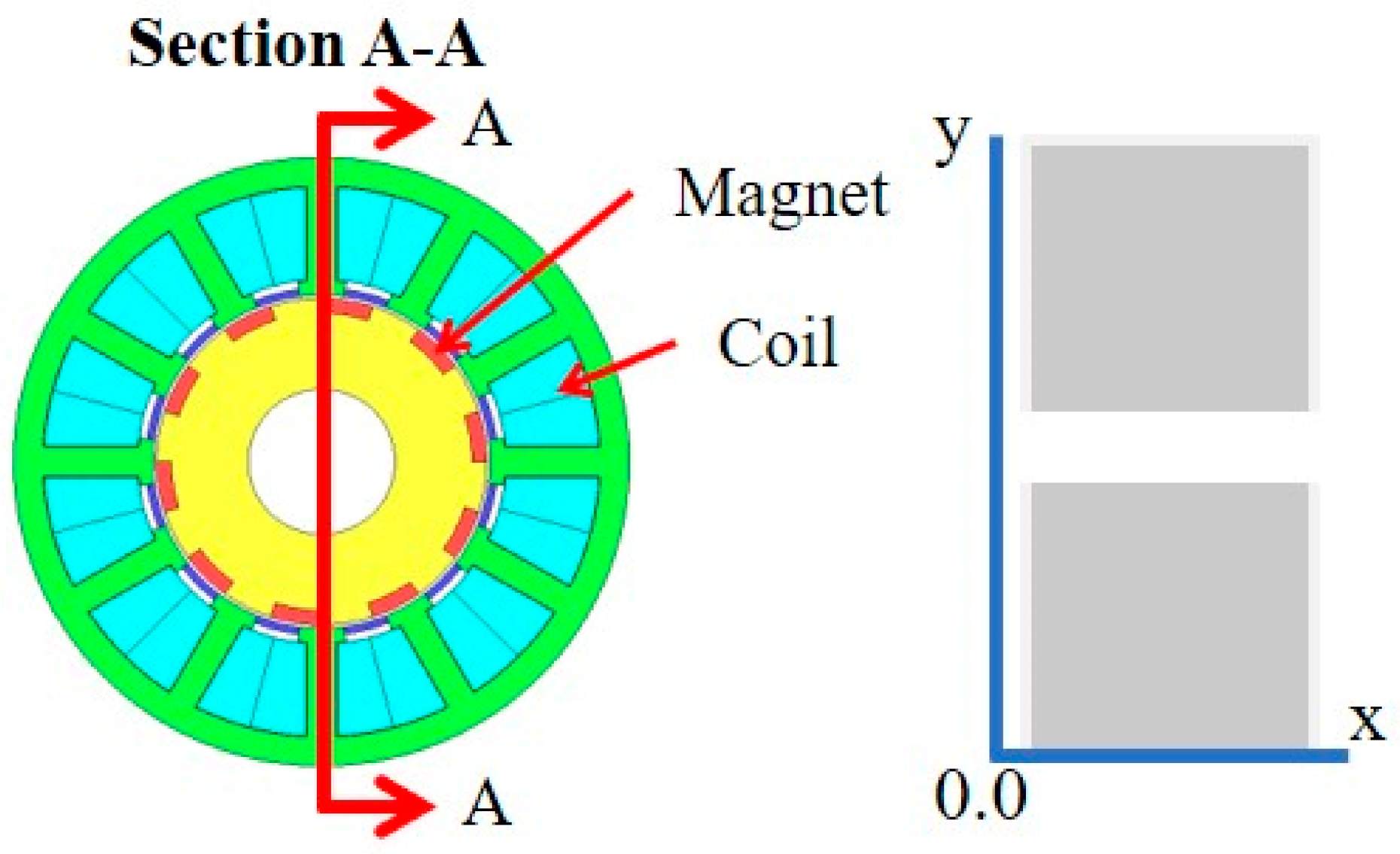

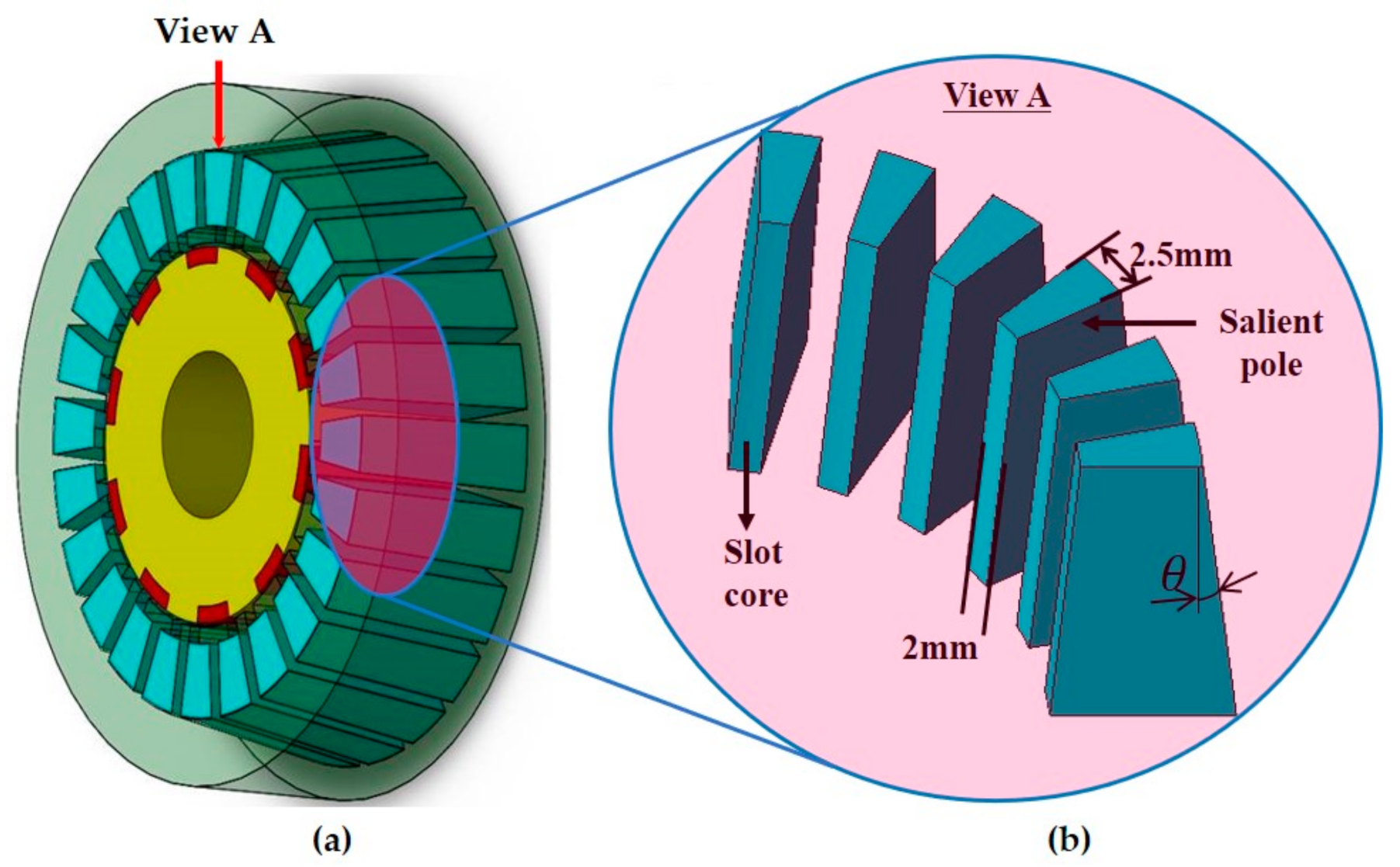
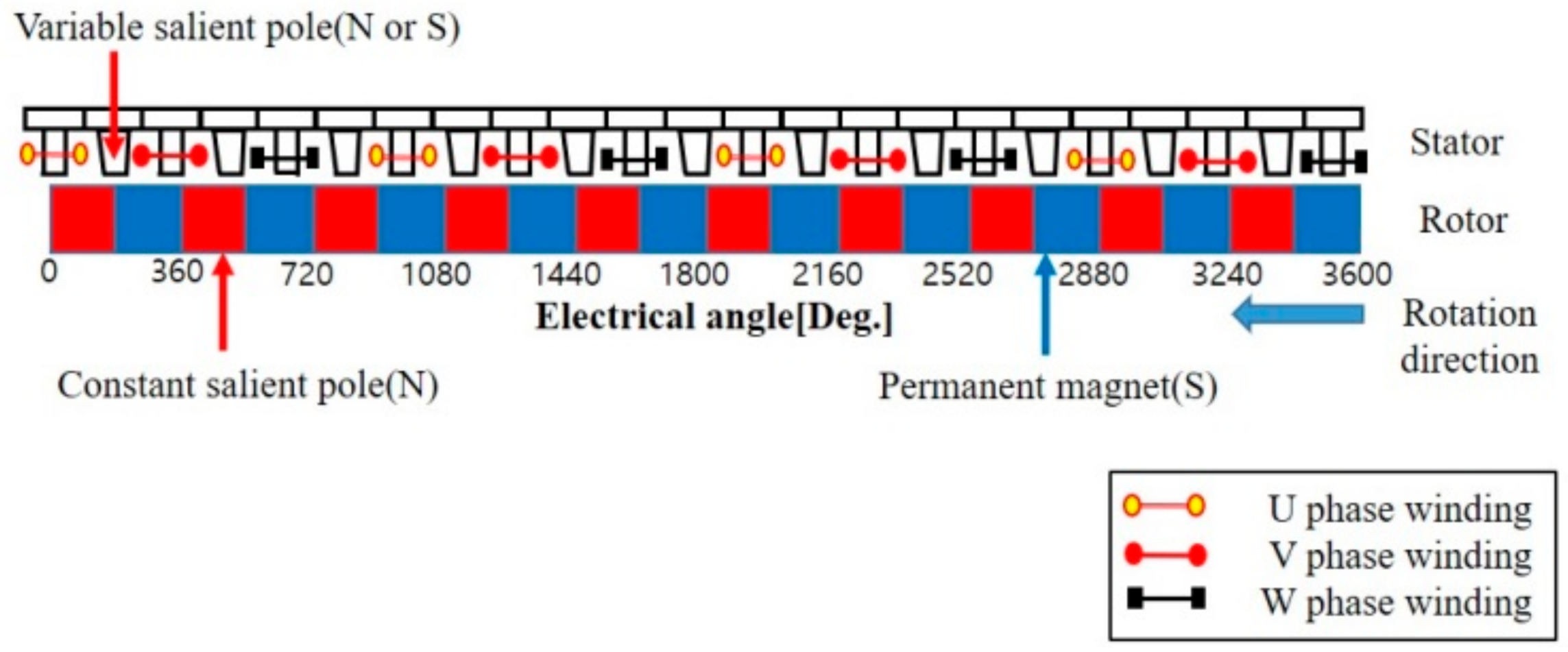
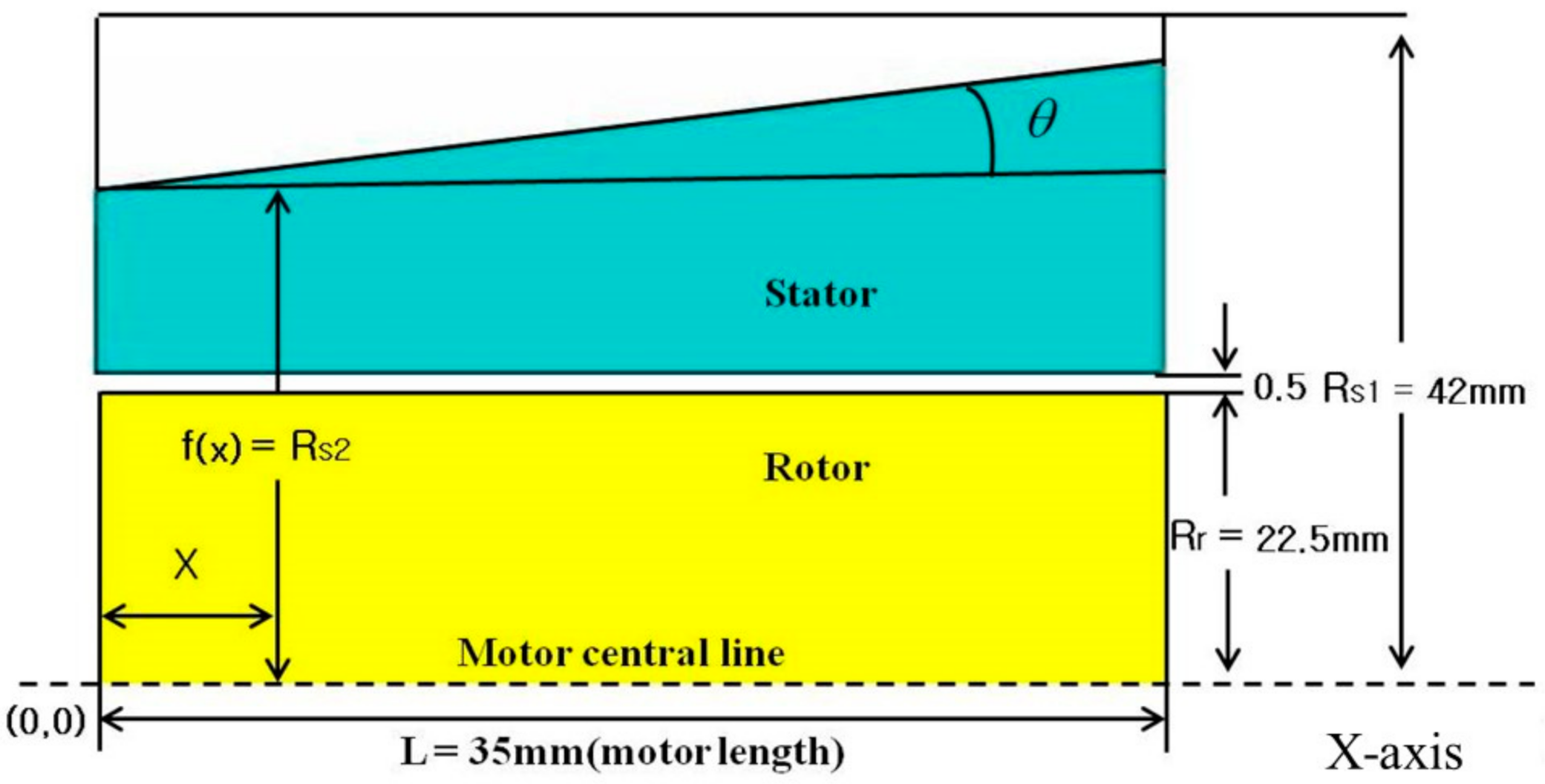
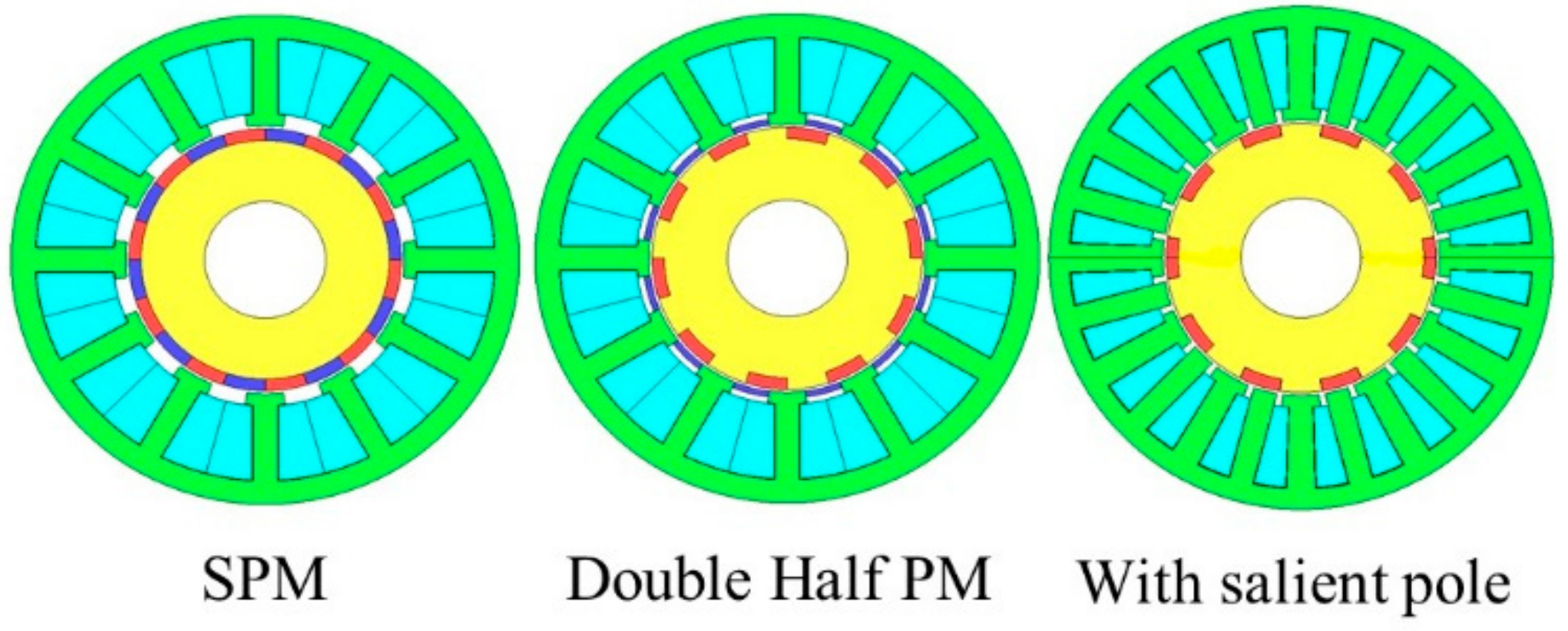
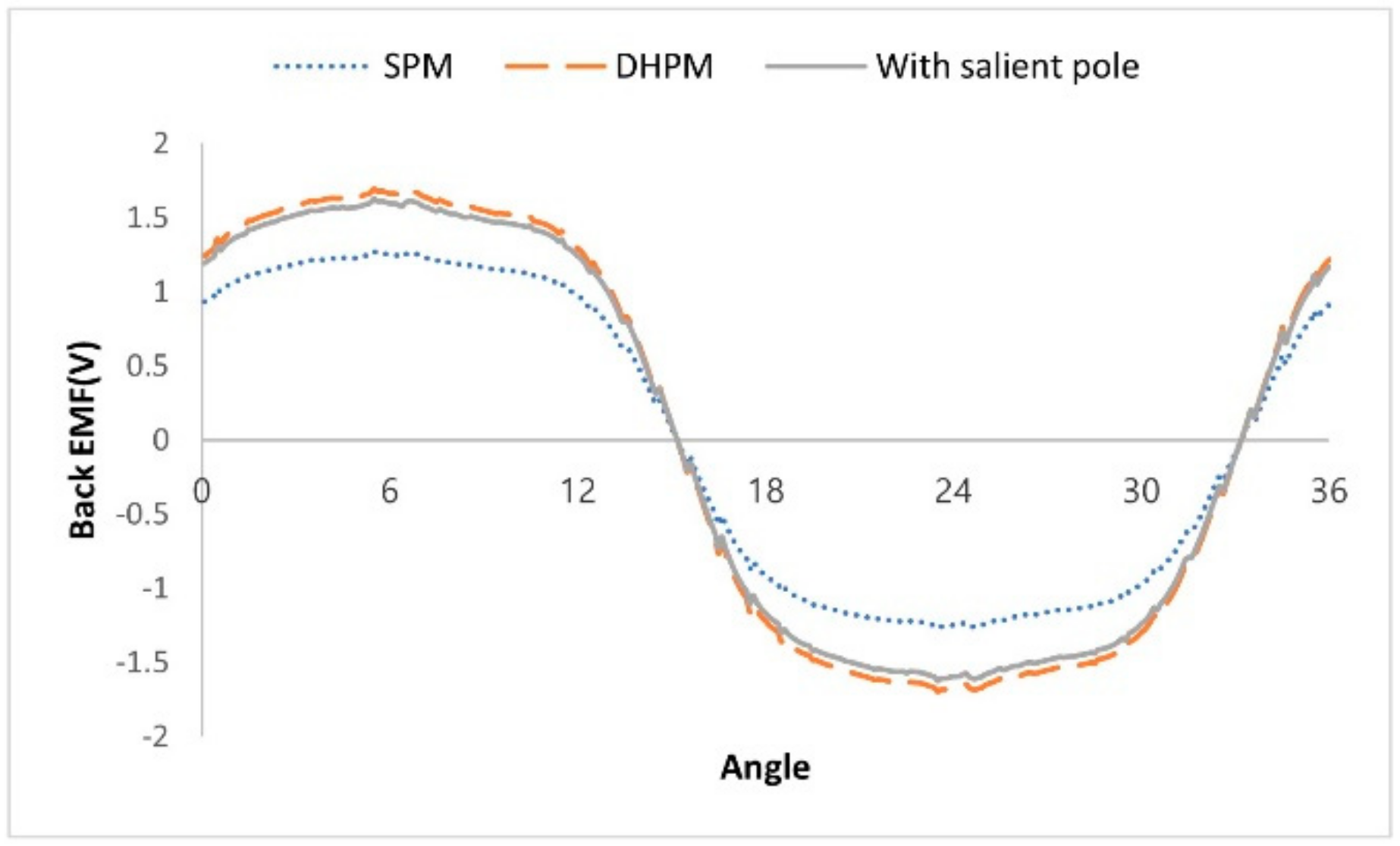
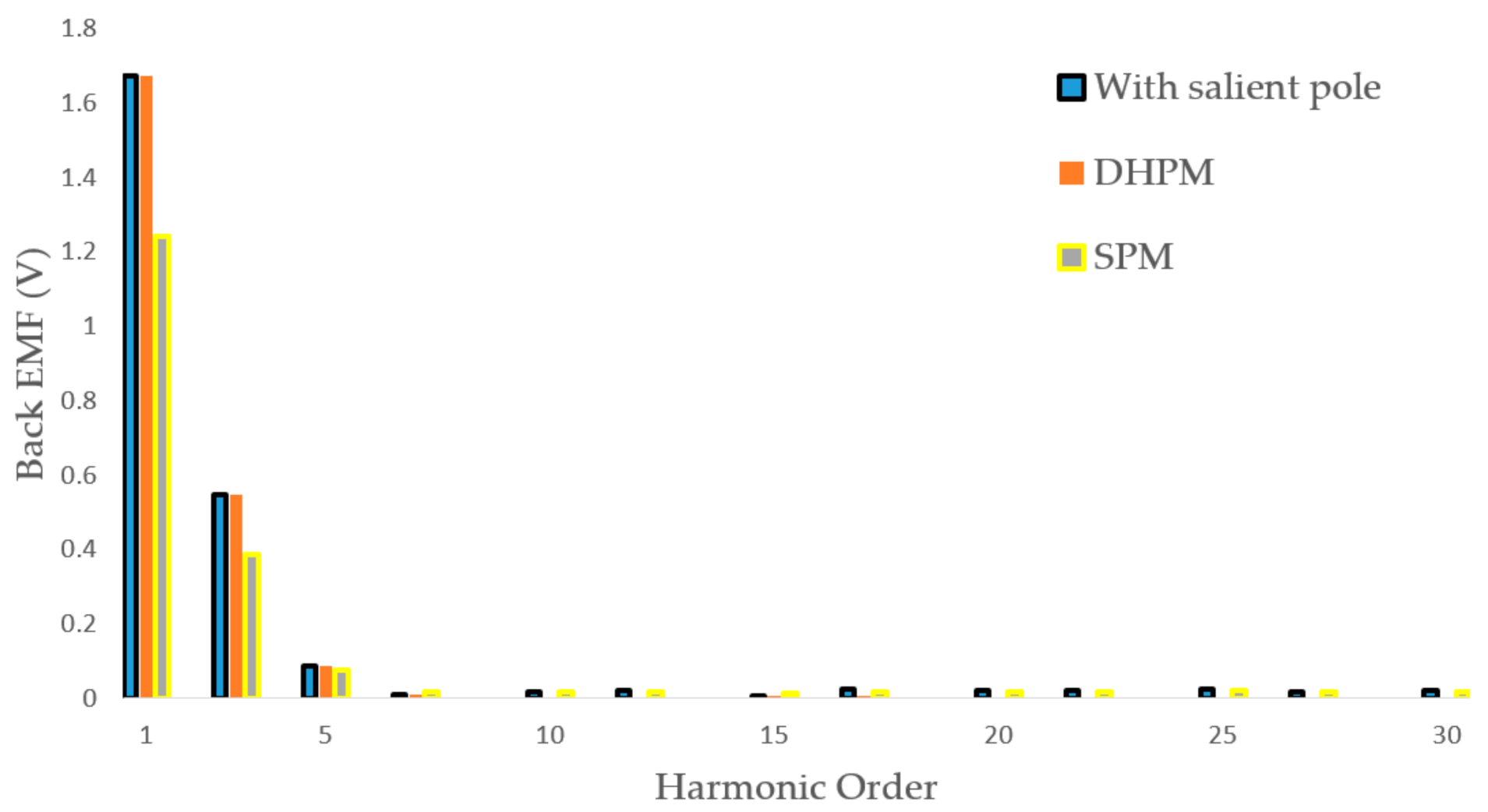

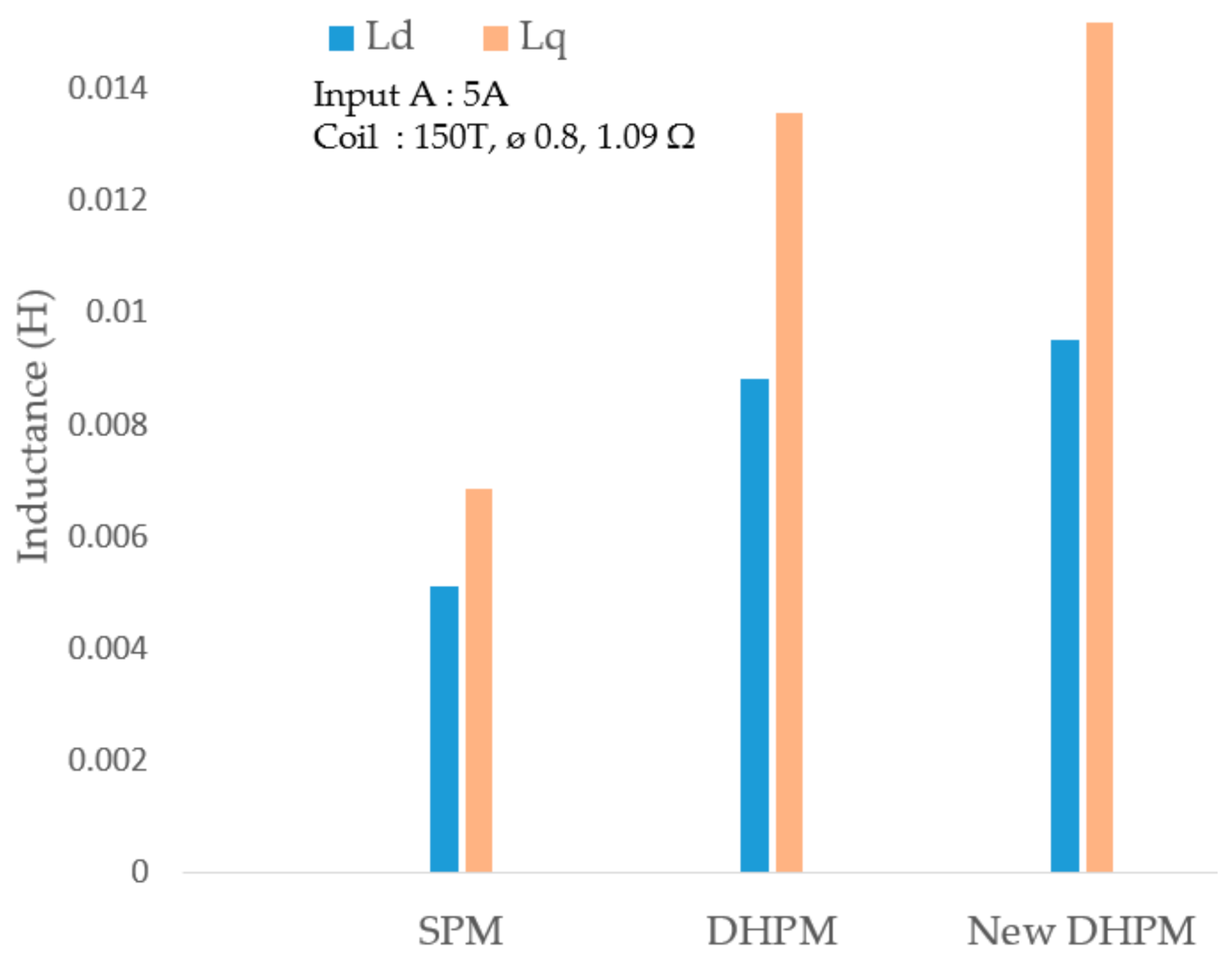

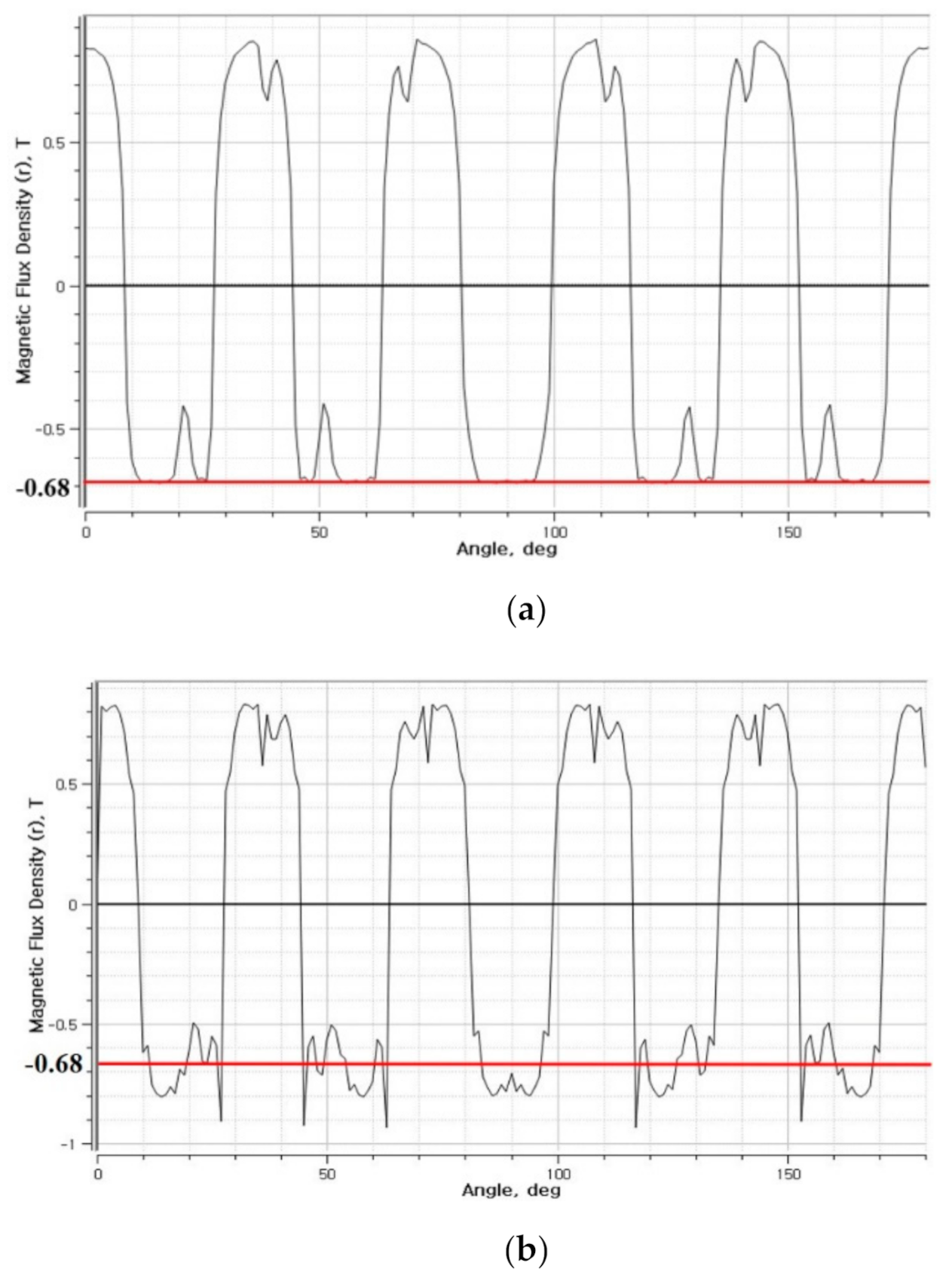
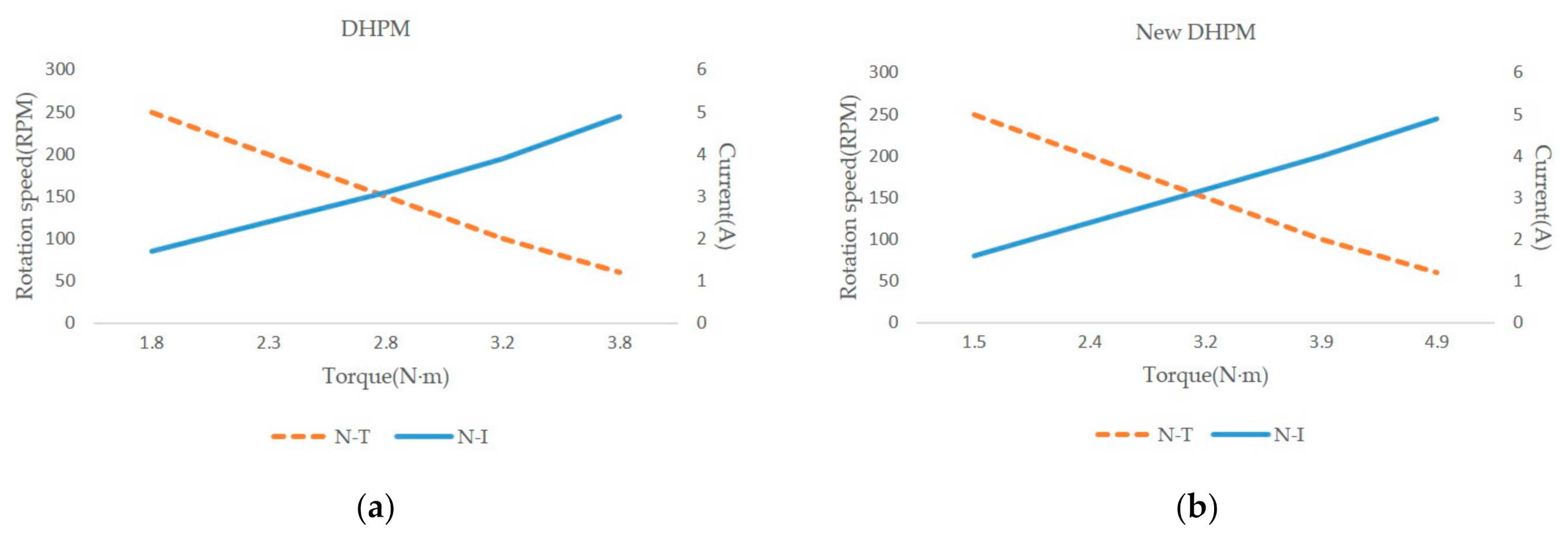
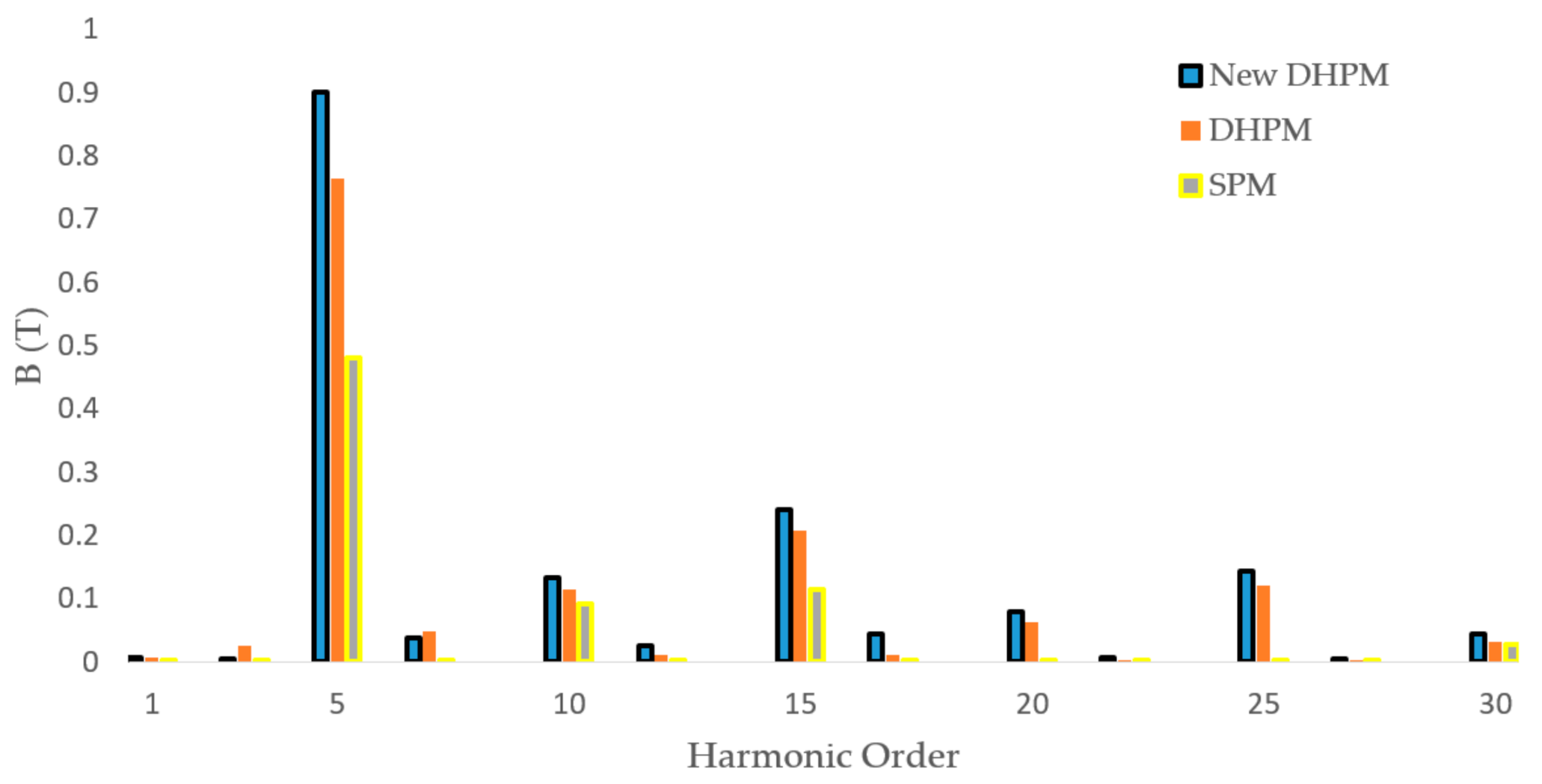
| Air gap length | 0.5 mm |
| Coil | 0.8 mm, 1.09 Ω |
| Coil turn number | 150 |
| Magnetic thickness | 2 mm |
| Outside diameter | 84 mm |
| Thickness | 35 mm |
| Items | Classification of the Vernier Motor | |||
|---|---|---|---|---|
| SPM | Rotor Half | Stator Half | Double Half | |
| Back EMF [V] | 1.24 | 1.18 | 0.26 | 1.68 |
| Torque [N∙m] | 2.42 | 2.40 | 0.49 | 3.85 |
| Items | New DHPM Vernier Motor |
|---|---|
| Angle of inclination of saddle motor | 7.5° |
| Maximum Outside diameter | 82 mm |
| Motor length | 35 mm |
| Air gap length | 0.5 mm |
| Coil | 0.8 mm, 1.09 Ω |
| Coil turn number | 150 |
| Magnetic material | 50JN400 |
| Items | SPM | A Conventional DHPM Vernier Motor | A Proposed DHPM Vernier Motor |
|---|---|---|---|
| Saddle motor inclination angle | 0° | 0° | 7.5° |
| Coil turn number | 150 turn | ||
| Torque constant, Kt (N∙m/A) | 0.484 | 0.77 | 0.984 |
| Back EMF | 1.24 | 1.68 | 2.25 |
| Torque | 2.42 | 3.85 | 4.92 |
| Space volume ratio of motor | 1 | 1 | 0.89 |
| Ld(H) | 0.005130 | 0.008814 | 0.009514 |
| Lq(H) | 0.006866 | 0.013573 | 0.015190 |
| Items | Magnetic Flux (T) | ||
|---|---|---|---|
| SPM | A Conventional DHPM Vernier Motor | A New DHPM Vernier Motor | |
| 5 | 0.480819 | 0.763385 | 0.899748 |
| 10 | 0.090819 | 0.113896 | 0.132117 |
| 15 | 0.113896 | 0.207868 | 0.239260 |
Publisher’s Note: MDPI stays neutral with regard to jurisdictional claims in published maps and institutional affiliations. |
© 2021 by the authors. Licensee MDPI, Basel, Switzerland. This article is an open access article distributed under the terms and conditions of the Creative Commons Attribution (CC BY) license (http://creativecommons.org/licenses/by/4.0/).
Share and Cite
Chang, S.; Niguchi, N.; Lee, J.-H.; Hirata, K. Improvement of Torque Performance and Energy Density of PM-Type Vernier Motor Utilizing Saddle Coil and Salient Pole. Appl. Sci. 2021, 11, 2818. https://doi.org/10.3390/app11062818
Chang S, Niguchi N, Lee J-H, Hirata K. Improvement of Torque Performance and Energy Density of PM-Type Vernier Motor Utilizing Saddle Coil and Salient Pole. Applied Sciences. 2021; 11(6):2818. https://doi.org/10.3390/app11062818
Chicago/Turabian StyleChang, Sungwoo, Noboru Niguchi, Je-Hoon Lee, and Katsuhiro Hirata. 2021. "Improvement of Torque Performance and Energy Density of PM-Type Vernier Motor Utilizing Saddle Coil and Salient Pole" Applied Sciences 11, no. 6: 2818. https://doi.org/10.3390/app11062818
APA StyleChang, S., Niguchi, N., Lee, J.-H., & Hirata, K. (2021). Improvement of Torque Performance and Energy Density of PM-Type Vernier Motor Utilizing Saddle Coil and Salient Pole. Applied Sciences, 11(6), 2818. https://doi.org/10.3390/app11062818






